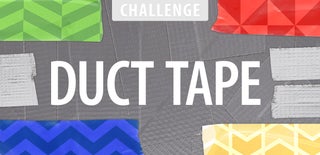Introduction: Decorative Duct Tape Piano Keyboard
Duct tape is the perfect starting point for making a decorative piano keyboard. Apply white duct tape (for the white keys) to a black surface. The black keys are shaped by partly cutting-away duct tape strips. Measures of the exact positions of the keys have been recorded and documented (see next step) to achieve maximum resemblance with a piano keyboard. In this Instructable the black surface of a cargo bike was turned into a decorative musical keyboard.
Besides its decorative purpose, the resulting piano keyboard may also be useful for practicing piano keys.
This Instructable was submitted to the Duct Tape Challenge (2017) and was first published on 30 January 2017 under a Creative Commons Attribution license by Openproducts.org at Instructables.com. See Step 3 in this Instructable for some words on how the contents of this Instructable may be used for other purposes.
If you like this Decorative Piano Keyboard from Duct Tape on a cargo bike feel free to retweet from or to follow Openproducts' Twitter account (see January 2017). Among the 30+ Instructables published by Openproducts there are some that also are bicycle-related, see the gallery here. Perhaps Openproducts' online shop is also worth a visit: https://openproducts.etsy.com.
Step 1: Measures From a Piano Keyboard
The calculation spreadsheet introduced here is a tool to determine scaled variants for the key-layout of a musical keyboard. It contains measures in [mm] of the piano key layout (fixed base parameters). Based on the desired width (an input parameter in [mm], for example equaling a band of duct tape) a scaling factor is calculated, which is applied to yield the measures of piano keys exactly matching your duct tape width (the resulting output measures are reported in [mm] and [in]).
The spreadsheet is defined as an Open Document Spreadsheet (.ods) which is a modern open standard file type, to be opened and edited in any spreadsheet software.
The next step gives a few hints on the actual making of the decorative musical keyboard.
Step 2: Making
Some hints on the actual making of the decorative piano keyboard:
- Preferably use cloth-backed duct tape because it doesn't shine through;
- Cutting the notches (the cut-away black keys) can be done with a pair of scissors;
- The point where the black keys end (at the crosswise cut) is an important reference for aligning the keys. The start and the end of the white keys may be best aligned using a final cut after all keys are in the correct position;
- Lengthwise cutting the duct tape requires some skills. Remain patient and prepare mentally to start all over again (and remember: practice makes perfect).
The next step elaborates on the Creative Commons license under which this Instructable and the calculation spreadsheet are published.
Step 3: License
This Instructable is being made available through a Creative Commons Attribution 4.0 International License. Republishing this Instructable is allowed, provided it is being attributed properly (cite the name Openproducts as an author and link to www.openproducts.org, www.instructables.com/member/openproducts, or to the original Instructable. In addition mention a copyright notice, a license notice, a disclaimer notice). For other arrangements send a Private Message through the Instructables member page.

Participated in the
Duct Tape Challenge 2017














